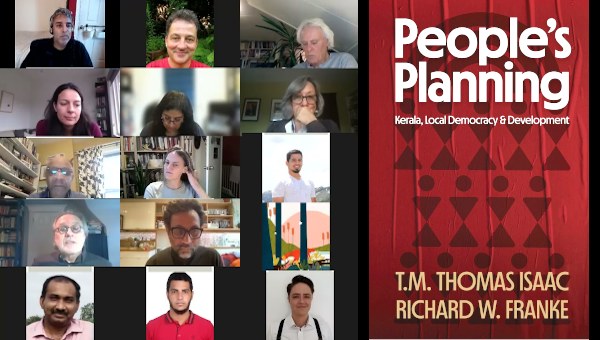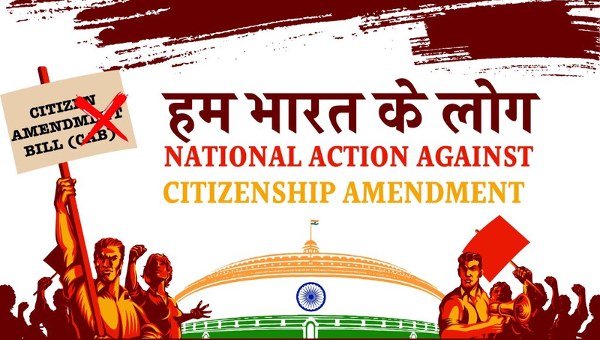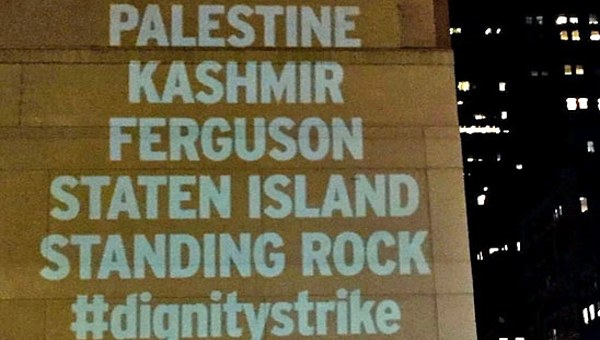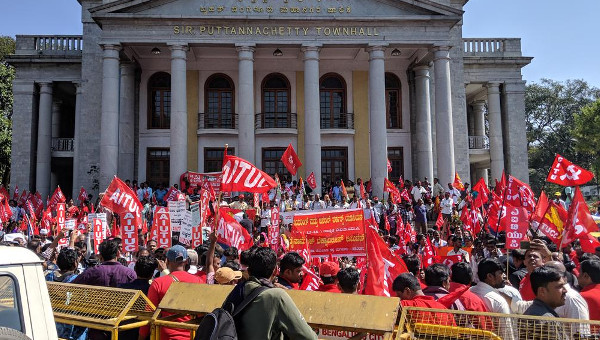There are things. And there are conditions of existence of things. In India, as in all countries of the world, many social problems exist. Close to 700 million Indians do not have access to food that will provide the minimum number of calories required for a healthy life. In other words, there is a massive amount of absolute poverty. And then there are conditions of existence of problems such as poverty. These conditions include not only anti-poor economic policies of a government but also anti-democratic measures which stop people from fighting against poverty, in a united and effective way. These measures include those that divide up the masses along lines of religion and crush dissent that challenges a government’s pro-business policies or actions of its foot-soldiers. This is indeed what we witness now-a-days in India which is under a rabid right-wing Hindu nationalist government exhibiting fascistic traits.[1] The deployment of anti-democratic measures becomes a positive condition for the existence of poverty and similar problems.
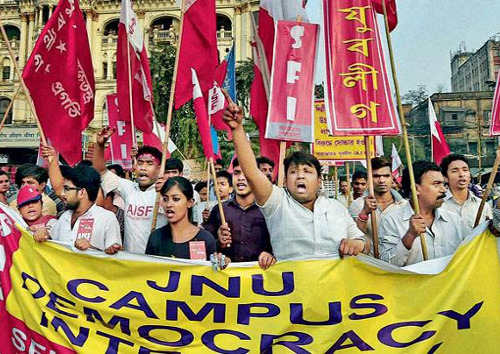
The struggle to remove poverty and similar problems must include the struggle against the conditions for these problems. This latter struggle includes the struggle for the very right to struggle. So, the struggle against social problems is really a two-pronged struggle: a) the struggle against the cause of these problems that lie in the economic/class system, including government policies, and b) the struggle to create conditions for this struggle.
The Two-Pronged Struggle for Democracy
Given that the bourgeoisie is increasingly ‘reneging’ on its promise to protect minimum democratic rights as in a liberal democracy, the struggle against poverty, etc. increasingly requires a political struggle. This is the struggle, for example, against the attempts of the bourgeois elements to divide the ‘nation’ of exploited classes (the ‘nation’ of workers and poor peasants and adivasi small-scale or ‘communal’ producers) along the lines of religion, region, language, and caste, etc. The political struggle of ordinary people includes the struggle against the conditions for the religious right and casteists, etc. to exist; the political struggle means the struggle to unite the exploited and oppressed groups so they can then struggle against the cause of the social problems, and therefore struggle against the structural forces which create disunity, along lines of religion, caste, location, etc. Every political struggle is a struggle to and struggle against.
One may argue that what is being suggested above goes against the following revolutionary-Marxist idea. A successful struggle against the undemocratic nature of contemporary bourgeois society[2] must be a part of a struggle for the abolition of the class relation itself because no struggle for democracy can be successful in a genuine, thorough-going, and enduring manner without it being also a struggle against the class rule. This is especially true in the poor countries where the bourgeoisie is scared of the rising working class which is expanding in its numerical size. Even in the rich countries, given rising inequality (that Thomas Piketty and others have been talking about), capitalism is increasingly incompatible with liberal democracy, even as a mask of class rule, and this partly explains the popularity of Bernie Sanders in a country where the utterance of the word socialism is considered a sin. So struggle to achieve democracy must be itself a struggle against the class rule.
I would, however, dialectically defend the distinction between the two forms of the struggle (struggle against the structural cause of social problems and ‘the political struggle’): they are different but connected. Let me explain.
Economy and Politics of Class
Everything in the world has a unitary cause, and subject to this fact, it also has multiple causes operating at different ontological levels, although not all these causes are of equal importance. For example, the primary cause of poverty and similar problems is in the unequal control of society’s resources, in the class-relation of exploitation, and other processes associated with class relations (e.g. competition, periodic crisis of the capitalist economy, etc.). But class is not merely an economic thing. It is also political.
The capitalist state is co-responsible for poverty (its magnitude, its distribution across social groups and areas, and so on). Poverty and social problems in general are political in that sense. They are political in an additional sense. The state helps the ruling class treat some groups of people such as low-income working class women, non-elite adivasis, Muslims, etc. as subhuman or as second-class citizens who have less than one unit of citizenship. Such a treatment allows their super-exploitation: they can be paid a below-average-wage. As well, the state divides the mass of people who would otherwise struggle against poverty and other social problems that harm them. The state takes away from them their right to fight, and becomes violent when they do exercise their right to fight where it exists. This is how the state is responsible for (the continued existence of) the problems.
A similar strategy is followed by non-state groups (e.g. Hindutva parivar elements) which are outside of, but also, increasingly, linked to, and occupying positions inside, the state. They weaken the forces that can fight against poverty and its underlying class-dynamics. Scarcity of jobs and government benefits, etc. is socially produced by a class system, but scarcity is blamed by the dominant groups (by, for example, the middle class Hindus) on religious and ethnic minorities.[3] That is why: to struggle against social problems requires a struggle to create the conditions for that struggle: such conditions include creating ideological-political unity among the oppressed and exploited elements.
In the present Indian condition, this means that people will have to struggle for protecting and deepening democratic rights. This is an imperative given the attack on these rights by the state and fascistic Hindutva elements surrounding the state, and inside the state, which uses the ideology of the nation and religion to crush any dissent. There is no doubt that large sections of big business are in an alliance with, and support, these ultra-conservative, semi-fascistic elements, directly or indirectly. After all, they are the ones who would benefit from a ‘united’ country and not a country where the working masses regardless of their religion and other social non-class positions rise against them. So the struggle for democracy must eventually become a struggle against the political interests of the bourgeoisie, and such a struggle, given proper leadership, can grow over into a struggle against their economic interests.
The Political Form of the Struggle for Democracy
What class form will such political struggle, the struggle for democracy, take? One answer is as follows. Workers, small-scale self-employed producers, and their political parties/movements and class-conscious trade union members as well as their progressive organic intellectuals and independent activists participating in class-based social movements, all these elements can come together, at local, regional and national levels, starting from a city-neighbourhood and rural hamlet. These elements will form working class action committees, with the aim of struggling for the democratic rights of these basic classes and class-fractions, in the first instance. These rights include the right to practice any religion one wishes, the right to eat whatever food one chooses (beef or not), the right to be free from caste, gender, linguistic and geographical discrimination, the right to free speech and public assembly without intimidation from the state forces and private forces (e.g. so-called moral police of the Right), the right to receive an education that respects scientific temper, secularism and internationalism, and so on.
There is no reason why such a struggle cannot be independent of all bourgeois parties.[4] In fact, to have any traction, the political struggle must have that class independence vis-à-vis at least the big business parties and big business as a class. What is needed, in India (as elsewhere in similar contexts), is a class-based ‘coalition’ (i.e. a ‘united front’)[5] of political forces outside of – and in an antagonistic relation to – the political space occupied by forces supporting the two big-business parties (Congress and BJP), in order to struggle for democracy (and more). And the working class and semi-proletarians must have their own independence: they must possess, and they must exercise, the right to launch ideological criticisms against the elements within the united front that maintain a conciliatory approach to the dominant classes.
One may ask: on what these forces will put pressure in their political struggle?[6] On a bourgeois government (e.g. on a Congress or BJP government in India)? Or, will these basic classes and their organic intellectuals try to form a government of their own, which will respect secularism and democracy? Or, will they remain as an extra-governmental power bloc and merely put pressure on whichever government there is, i.e. pressure for secularism, for democracy, etc., in order to create conditions for the struggle for the abolition of the bourgeois system? These are difficult questions. My personal view is that if and when conditions allow, the demand must be made for a government of ordinary workers, landless/land-poor peasants, and the salaried elements of the urban working class, and independent producers in urban areas.
But there is no doubt that: the more this political struggle consciously becomes a part of the struggle against the system of class rule as such – i.e. the more this political struggle relates the attack on democracy and people’s living standards to their class origin – the more effective will it be in winning what are political-democratic demands in the first instance, and even some economic demands in the short term.
Working Class: Agents of Change
The main agents for such struggle for democracy (and for economic concessions) must be workers, and small-scale producers who do not exploit others. As is widely known now, democratic measures and welfare benefits have been granted in the West and elsewhere more or less because of the threat of a 1917 (or 1949 perhaps) there. Typically major concessions are given by the ruling class when there is a threat to its class position, and not merely because of the threat to the political power of this or that party of this class or merely because of the trade union struggle, although the latter forms of struggle are important in that they add to the impact of major revolutionary upsurges such as 1917. There are definite limits to the extent to which in the current conjuncture characterized by what appears to be capitalism’s terminal decline, a ruling class will concede to democratic demands (and significant economic concessions). This is especially the case when the undemocratic conduct[7] has become an important way in which the ruling class in a liberal democracy rules. In India, the bourgeoisie’s failure to protect people’s democratic rights (including right to freely unionize) and the failure to concede to demands for meagre improvement in living standards, during the Congress regime was a condition of existence for the current attack on democracy and living standards by the Right; and the Right’s attack on democracy is even more severe than in the previous regime. Both parties (and the class forces behind them) have together shown that they – and thus the big business class whose interests they represent – are unsuitable to rule. And large sections of the masses are increasingly not tolerating the present state of affairs (e.g. attack on democratic rights and on their basic living standards), as indicated by numerous acts of resistance and strikes in different places in India.
The Hindu Right, both within the state and outside, is the greatest threat to democracy. It must be fought on all fronts. The subjective raw materials – conditions of existence – exist for that struggle. 31 per cent votes were cast for the BJP at the 2014 national election. This means that merely 20 per cent of the eligible voters, or, 14 per cent of India’s population, supported it. In other words: potentially, 86% of India, 80% of eligible voters, and 69% of the people who voted did not support the BJP. This massive subjective force can produce the conditions for the struggle for democracy and secularism. This is the struggle of the 69% vs 31%, or indeed 86% vs 14%. And this 31% or 14% includes many people whose support is akin to marrying on a rebound: they voted for the BJP not because they supported it but because Congress, BJP’s economic other, disappointingly failed to meet the needs of the people. There was no credible secular progressive national scale alternative on offer.
On the other hand, there are millions of ordinary people who vote for Left parties[8] (at least 25 million people voted for left parties at the last election). The Communist Party-Marxist (CPM) alone has over a million Party members, and its mass and class organizations have a total membership of 70 million. In a large majority of left-oriented constituencies, left parties are major forces; they have lost partly because of the faulty electoral system (the first-past-the-post system).[9] The left parties’ vote share in West Bengal is nearly as much as BJP’s vote share at the Center. The Left has not too long ago received overwhelming electoral support at local elections in Tripura; it indeed has increased its vote share. There are millions of people in Left-oriented unions in the country. In addition, there are progressive civil society organizations, including those of artists and writers, associated with the left. There are secular-minded people in smaller non-Left parties (including in what are called socialist parties, which are merging to form a united party, and in a ‘middle class party’, called Aam Admi Party); class-conscious workers in those parties may join – or provide some support to – the united front. India still has one of the largest concentrations of progressive intellectuals in the world who are committed to scientific and secular values, and who think from the standpoint of the working masses (workers and small-scale independent producers), however inadequately.
All in all, India has a large left and secular-democratic ideological-political apparatus. That needs renewal and new energy. Armed with a proper class perspective and education, which unpacks the connection between class relations and the attack on democracy and which guides a class-oriented struggle for democracy and secularism, such a counter-hegemonic apparatus can create conditions of the existence for the struggle against poverty and other social problems. This apparatus can struggle for democracy and secularism and for an improvement in the standard of living, as conditions for existence for an uninterrupted struggle for a workers’ and poor peasants’ government. This struggle for democracy and secularism will announce to members of the bourgeoisie, whether they support rabid communalists or are formally secular, that their economic rule is in trouble, not only because it has failed to satisfy the needs of the masses while living off their labour with opulence but also because it has failed to respect the minimum standards of democracy. Of course, most parts of this ideological-political apparatus are unlikely to be clear about socialist goals. And, the question is then who will lead such a broad united front type movement, a movement within which class and democratic consciousness will be inevitably uneven. Under these conditions and given that Left movements have generally been more social democratic and electoralist than revolutionary, it is easy for the extant small-scale genuinely revolutionary forces to politically isolate themselves from the masses, to indefinitely wait for the right moment, and to think that their only goal now is the production of revolutionary (online) educative material. That would be a mistake. One is reminded of Lenin’s (1922) point here which he made in “On the Significance of Militant Materialism”:
“One of the biggest and most dangerous mistakes made by Communists…is the idea that a revolution can be made by revolutionaries alone. On the contrary, to be successful, all serious revolutionary work requires that the idea that revolutionaries are capable of playing the part only of the vanguard of the truly virile and advanced class must be understood and translated into action. A vanguard performs its task as vanguard only when it is able to avoid being isolated from the mass of the people it leads and is able really to lead the whole mass forward.”
The movement for democracy and for an improvement in living standards must be seen as a series of concentric circles, the innermost circle representing fight for socialism and for state power. This movement must play an educative role in the political sense: by struggling for democracy and for economic concession, the masses will use whatever they receive to further their struggle, and they will learn what the limits to their success are, and they will learn what combination of methods for struggle works in what context. Ideological education through pamphlets (online and offline) and speeches (electoral or academic or otherwise) and study circles and so on is absolutely important in order to produce a counter-hegemonic culture (Das, 2011), but ideological education, abstracted from actual mass struggles, can be futile beyond a point. When millions of people are suffering under grinding poverty and are facing attack on their democratic rights, when these objective conditions exist, it is criminal not to strengthen the hammer and sharpen the sickle of the subjective forces: the contradiction between the class-objective forces and class-subjective forces must narrow. And the united front movement must deploy multiple forms of struggle. It is instructive to return to Lenin (1920):
“History as a whole, and the history of revolutions in particular, is always richer in content, more varied, more multiform, more lively and ingenious than is imagined by even the best parties, the most class-conscious vanguards of the most advanced classes. … [I]n order to accomplish its task the revolutionary class must be able to master all forms or aspects of social activity [including legal and illegal methods] without exception…; second, that the revolutionary class must be prepared for the most rapid and brusque replacement of one form by another.”
Conclusion
Shortly after coming to power, the Hindu right government recommended the promulgation of ordinances for auction of coal blocks and increasing the foreign investment ceiling for insurance from 26% to 49%. Given the determined resistance to its reforms agenda from the opposition, it failed to get the bills passed in the parliament. Replying to a question as to what was the urgency to bring an ordinance a day after the winter session concluded, the Finance Minister said: “There has been too much delay. That is why there is urgency.” How can delay – that is, something not happening on time – itself explain urgency? The answer is tautological. The Minister is hiding the real cause for urgency. But he could not entirely hide his feelings for the economic masters. He said: “It [the ordinance] announces to the rest of the world, including investors, that this country can no longer wait even if one of the Houses of Parliament waits indefinitely to take up its agenda” [italics added].[10] So, democratic method or not, the government is keen on paying back the bourgeoisie which placed it in power through its money power. The government will not wait.
If the government exercises this kind of urgency in acting in the interest of the ruthless dictatorship of monopoly bourgeoisie, and as a part of the same process of serving its bourgeois masters, the government crushes all forms of democratic right including free speech and assembly and the practice of religion, then the working masses must show a similar kind of urgency and announce to the political class and its economic masters their own intention: to take control over their own political destiny and to say that they also cannot wait eternally. •
This article first published on the sanhati.com website.


